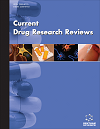- Home
- A-Z Publications
- Current Drug Research Reviews
- Previous Issues
- Volume 17, Issue 1, 2025
Current Drug Research Reviews - Volume 17, Issue 1, 2025
Volume 17, Issue 1, 2025
-
-
A Hidden Pandemic? Abuse of Gabapentinoids: A Brief Review of Recent Studies
More LessAuthors: Gamze Zengin İspir, Mustafa Danışman and Kübra Sezer KatarBackgroundGabapentin and pregabalin were developed for epilepsy and neuropathic pain. They work via voltage-gated calcium channels and are used for broad-spectrum diagnoses, e.g., epilepsy, neuropathic pain, other chronic pain syndromes, anxiety disorders, alcohol-drug withdrawal syndromes, agitation, insomnia, etc. Especially in a world dealing with the opioid crisis, gabapentinoids were considered safer alternative Read More
-
-
-
Advancing Green Chemistry in Antiviral Therapeutics: A Comprehensive Review
More LessAuthors: Kanderi Archana and Sumithra ManiCytomegalovirus (CMV) is a prevalent virus across the world that belongs to the family Herpesviridae but remains dormant in the body unless the immune system is compromised. In addition, when the bacterium is compromised without any health risks, the infection spreads from one person to another person through body fluids, such as saliva, blood, etc. Ganciclovir is an anti-viral medication used in treating viral infections, e Read More
-
-
-
Insightful Perspectives on Sodium-glucose Co-transporter 2 Inhibitors: Navigating Safety Updates and Beyond
More LessAuthors: Pratikeswar Panda, Rajaram Mohapatra and Biswajit SamantaraySGLT2 (Sodium-Glucose Co-transporter 2) inhibitors, also known as gliflozin class, are a novel family of oral drugs being used to treat type 2 diabetes. SGLT2 inhibitors can work alone or in conjunction with other medications. This class includes five drugs, including canagliflozin, ertugliflozin, sotagliflozin, dapagliflozin, and empagliflozin. SGLT2 inhibitors inhibit the SGLT2 cotransporter in the proximal tubules of the Read More
-
-
-
Natriuretic Peptides in Gastrointestinal Cancer: Biomarkers and Potential Therapeutic Targets
More LessGastrointestinal (GI) cancers are an important health problem globally. Natriuretic peptides are hormones that have a crucial role in human physiology. There are a variety of treatments for GI cancer, but conventional therapies have side effects and low efficacy. Studies have demonstrated that natriuretic peptides are therapeutic in different cancer types. Natriuretic peptides are best known for their involveme Read More
-
-
-
Clinical Similarity of Biosimilars and Reference Drugs: A Comprehensive Review and New Hope for Public Health in a New Frontier
More LessBackgroundPatents and exclusive rights on reference biologics contribute to the emergence of biosimilars. Regulatory bodies, such as the Food and Drug Administration (FDA), World Health Organization (WHO), and EMA (European Medicines Agency) for assessing clinical safety, effectiveness, and consequences between biosimilars and reference medications, have established guidelines. Since generic small molecules from ref Read More
-
-
-
Therapeutic Management and New Upcoming Approaches for Age Related Macular Degeneration
More LessAuthors: Srishti Shetty, Kavita Singh and Kalyani BarveAge-related Macular Degeneration (AMD) is a severe eye illness that is going to lead in the race for incurable blindness globally among the elderly population. AMD is the third common reason responsible for affecting the quality of life globally. The macula and the retinal layers are adversely affected during AMD and are responsible for the loss of vision eventually. Numerous genetic variables, lipid metabolism, ageing and oxid Read More
-
-
-
Role of Essential Oils and Antioxidants in the Treatment of Fibrosis
More LessAuthors: Jaishree Sah and Indu SinghFibrosis is the leading cause of many lethal diseases. It is characterized by the accumulation of extracellular matrix (ECM) components, which leads to damaged tissue functioning in the influenced organs. Essential oils are concentrated hydrophobic liquid having volatile compounds extracted from plant or plant parts while antioxidants are the compounds that help in scavenging free radicals and prevent reducing the oxidation Read More
-
-
-
Advancement in Opioid Abuse-deterrent Formulation Technologies and Regulatory Expectation
More LessAuthors: Jayendrakumar Patel and Rakesh PatelChronic pain is a byproduct of many diseases and conditions. Along with long-term opioid medication use in chronic pain management, misuse of this vital medication has been a topic of much debate over the last two decades. Abuse-deterrent formulations play a critical role in comprehensive opioid risk management strategies, limiting the attractiveness and drug-liking qualities of an opioid drug by limiting their bioavailability, Read More
-
-
-
Modulation of Angiotensin-II and Angiotensin 1-7 Levels Influences Cardiac Function in Myocardial Ischemia-reperfusion Injury
More LessThe angiotensin-converting enzyme-2 (ACE-2) alters the pathophysiology of various fatal cardiovascular diseases, including ischemic heart disease, whereas angiotensin 1-7 (Ang 1–7) exerts a wide range of actions. The effects of ischemia-reperfusion (IR) injury include damage to myocardial tissue that initiates protease action, causing cardiac cell death. Angiotensin-II (Ang-II) contributes through the renin-angiotensin system ( Read More
-
-
-
Bioactive Fractions Isolated from Harungana madagascariensis Lam. and Psorospermum aurantiacum Engl. Regulate Collagen and Melanin Biosynthesis Gene Expression in UVB-irradiated Cells with Additional Anti-inflammatory Potential
More LessBackgroundHarungana madagascariensis (HM) and Psorospermum aurantiacum (PA), used traditionally for skin care, have been reported to upregulate the expression of intracellular antioxidant genes, thereby preventing melanoma and protecting fibroblast cell lines from Ultraviolet B (UVB)-induced intracellular oxidative stress.AimsThis investigation aimed to identify major compounds in bioactive fractions using bioass Read More
-
Most Read This Month
Article
content/journals/cdrr
Journal
10
5
false
en


